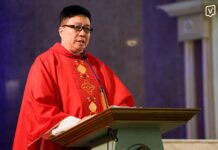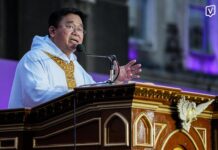THE UST Alumni Priests Association (UST ALPA) has amended its Constitution to include former seminarians, marking the first “inclusive” homecoming of the Central Seminary last Jan. 28 to 30.
Fr. Amadeo Alvero, UST ALPA public information officer, said non-ordained members were included in the celebration as they were essential in the history of the Central Seminary.
“They have been forgotten for a very long time. For this year, we have to include them. Although they have other vocations taken after studying here, [even if they were] not ordained, they are [still] a part of us,” Alvero told the Varsitarian.
Alvero explained that the revision was led by ALPA’s executive board, along with Msgr. Bernie Pantin, the board chairman, and Fr. Arthur Opiniano, president of the host batch 1994.
Section 2 of Article 3 of the UST ALPA Constitution stated that “All who graduated or at least finished one semester of classes in any of the Ecclesiastical Faculties but did not receive the sacred orders are considered as associate members.”
The association honored three alumni who were raised to the episcopate: Iba Bishop Bartolome Santos Jr., Antipolo Auxiliary Bishop Nolly Buco and Kabankalan Bishop Louie Galbines.
Among the eight golden jubilarians awarded were Msgr. Rolando Oliverio, Fr. Josefino Sebastian, Fr. Erno Diaz, Antonio Hidalgo, Erasmo Lapig, Jose Parohinog, Msgr. Nicasio Melicor and Fr. Felipe Maticas.
UST Rector Fr. Herminio Dagohoy, O.P. was among the 28 recipients of the silver jubilarian award.
“Sixteen Benjamins,” newly ordained priests, took their oaths as new ALPA members while 18 associate members of batch 1993 were given the silver jubilarian award.
Exhibit bravery, herd the youth
In his homily, Santos urged his fellow Thomasian priests to be courageous in executing their mission for the Church.
“We have many Thomasian priests standing side by side with the poor to fight for justice and peace; [w]ho put courage to serve his parishioners from calamities. Only God knows who protects their cub from the wolves using only their bare hands and bended knees,” Santos said.
Meanwhile, lawyer Antonio La Viña, former dean of Ateneo de Manila University’s School of Government, urged the clergy to return to being a missionary Church for the youth.
The youth is a sign of hope as they would “build the country” once the members of the clergy reach out to them, La Viña said in a conference during the homecoming’s second day.
“The one thing that [would drive] this country is the fact that there [are] a lot of young people. What’s different now, with the young people everywhere, they have access to the same things that everyone [have]. They have a strong advantage,” he added.
In line with the theme “Courageous, Creative and Faithful: Thomasians for the Youth,” Fr. Renato de Guzman said the clergy should strive to be a “synodal Church” and a Church that journeys with the youth.
The youth needs a Church that “listens, accompanies and discerns,” de Guzman said during the conference.
A challenge for the clergy is to help the young people realize their full potential, said Jude Liao, a youth coordinator from the Diocese of Cubao.
Another challenge for members of the lay ministry was to teach the fast-paced youth that not everything is instant, Liao said echoing the contents of the Filipino Youth’s Open Letter to the Catholic Church in the Philippines.
The letter talked about the concerns and goals of the young people in line with the celebration of the Year of the Youth.
A total of 258 Thomasian priests and non-ordained members returned to the University for the three-day event.













